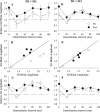Experiential modification of the trigeminal reflex blink circuit
- PMID: 17898213
- PMCID: PMC6673164
- DOI: 10.1523/JNEUROSCI.1152-07.2007
Experiential modification of the trigeminal reflex blink circuit
Abstract
To characterize the organization and plasticity of the trigeminal reflex blink circuit, we interacted blink-evoking supraorbital (SO) and infraorbital (IO) nerve stimuli in alert rats. Stimulation of either trigeminal branch produced a short-lasting inhibition followed by a longer-lasting facilitation of blinks evoked by stimulating the other nerve. When IO stimulation evoked a smaller blink than SO stimulation (IO < SO), SO stimulation facilitated subsequent IO-evoked blinks more than IO stimulation facilitated SO-evoked blinks. When IO > SO, IO and SO stimulation exerted equivalent facilitation of subsequent reflex blinks. To investigate whether the blink circuit obeyed rules analogous to those governing the associative and spike timing-dependent plasticity exhibited by individual synapses, we compared the effects of 3600 simultaneous IO and SO pairings, asynchronous IO and SO pairings, or synchronous IO and SO pairings separated by 20 ms on temporal interactions between IO and SO inputs to the blink circuit. Simultaneous pairing of a weak IO and a strong SO strengthened the IO input to the blink circuit, whereas asynchronous pairing weakened the stronger input. When the pairing pattern made an afferent input arrive after blink circuit activity, it weakened that afferent input. Analogous to synaptic modifiability, the results revealed that blink-evoking stimuli acted as a "presynaptic input" and blink circuit activity acted as a "postsynaptic spike." These mechanisms may create the maladaptive reorganization of trigeminal inputs in diseases such as hemifacial spasm.
Figures







Similar articles
-
Long-term potentiation of the human blink reflex.J Neurosci. 2001 Jun 15;21(12):RC151. doi: 10.1523/JNEUROSCI.21-12-j0002.2001. J Neurosci. 2001. PMID: 11404443 Free PMC article. Clinical Trial.
-
Role of cerebellum in adaptive modification of reflex blinks.Learn Mem. 1997 May-Jun;4(1):77-87. doi: 10.1101/lm.4.1.77. Learn Mem. 1997. PMID: 10456055
-
Sex, blinking, and dry eye.J Neurophysiol. 2020 Feb 1;123(2):831-842. doi: 10.1152/jn.00635.2019. Epub 2020 Jan 15. J Neurophysiol. 2020. PMID: 31940243
-
Reflex excitability regulates prepulse inhibition.J Neurosci. 2000 Jun 1;20(11):4240-7. doi: 10.1523/JNEUROSCI.20-11-04240.2000. J Neurosci. 2000. PMID: 10818160 Free PMC article. Clinical Trial.
-
Strategies for interfacing with the trigeminal nerves in rodents for bioelectric medicine.J Neurosci Methods. 2019 Aug 1;324:108321. doi: 10.1016/j.jneumeth.2019.108321. Epub 2019 Jun 20. J Neurosci Methods. 2019. PMID: 31229585 Review.
Cited by
-
Changes in blink reflex after simultaneous supraorbital and mental nerve stimulations in healthy subjects.Turk J Med Sci. 2024 Feb 12;54(3):563-571. doi: 10.55730/1300-0144.5823. eCollection 2024. Turk J Med Sci. 2024. PMID: 39050008 Free PMC article.
-
Evoking blinks with natural stimulation and detecting them with a noninvasive optical device: a simple, inexpensive method for use with freely moving animals.J Neurosci Methods. 2008 Aug 15;173(1):108-13. doi: 10.1016/j.jneumeth.2008.05.027. Epub 2008 Jun 13. J Neurosci Methods. 2008. PMID: 18598716 Free PMC article.
-
Corneal sensitivity following lacrimal gland excision in the rat.Invest Ophthalmol Vis Sci. 2015 May;56(5):3347-54. doi: 10.1167/iovs.15-16717. Invest Ophthalmol Vis Sci. 2015. PMID: 26024120 Free PMC article.
-
Effects of subthalamic deep brain stimulation on blink abnormalities of 6-OHDA lesioned rats.J Neurophysiol. 2015 May 1;113(9):3038-46. doi: 10.1152/jn.01072.2014. Epub 2015 Feb 11. J Neurophysiol. 2015. PMID: 25673748 Free PMC article.
-
Trigeminal high-frequency stimulation produces short- and long-term modification of reflex blink gain.J Neurophysiol. 2014 Feb;111(4):888-95. doi: 10.1152/jn.00667.2013. Epub 2013 Nov 27. J Neurophysiol. 2014. PMID: 24285868 Free PMC article.
References
-
- Abbott LF, Nelson SB. Synaptic plasticity: taming the beast. Nat Neurosci. 2000;3(Suppl):1178–1183. - PubMed
-
- Auger RG. Hemifacial spasm: clinical and electrophysiologic observations. Neurology. 1979;29:1261–1272. - PubMed
-
- Bartsch T, Goadsby PJ. Increased responses in trigeminocervical nociceptive neurons to cervical input after stimulation of the dura mater. Brain. 2003;126:1801–1813. - PubMed
-
- Battaglia F, Ghilardi MF, Quartarone A, Bagnato S, Girlanda P, Hallett M. Impaired long-term potentiation-like plasticity of the trigeminal blink reflex circuit in Parkinson's disease. Mov Disord. 2006;21:2230–2233. - PubMed
Publication types
MeSH terms
Grants and funding
LinkOut - more resources
Full Text Sources
Other Literature Sources
